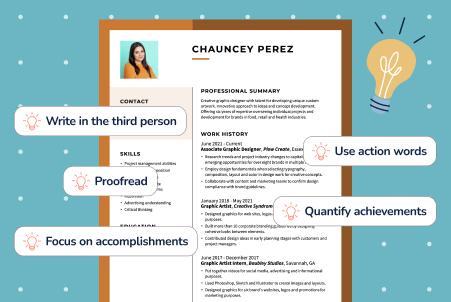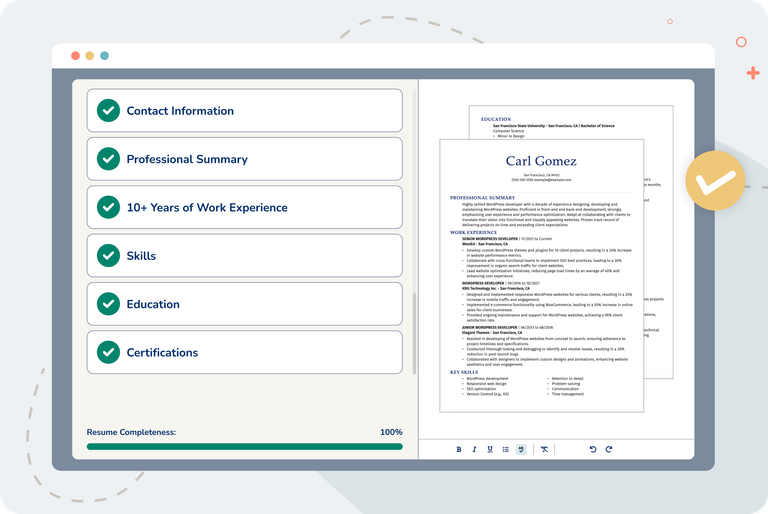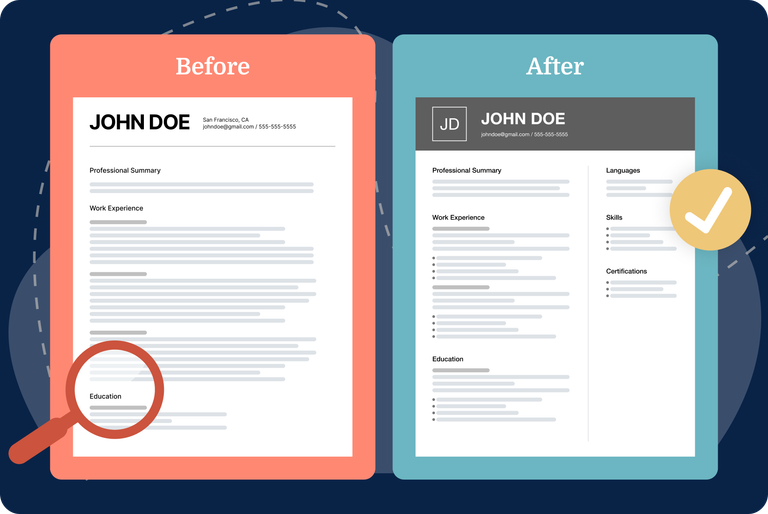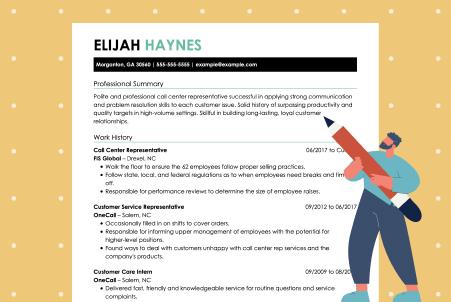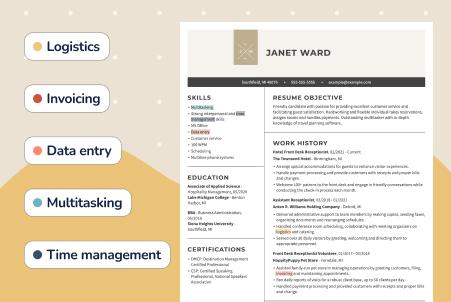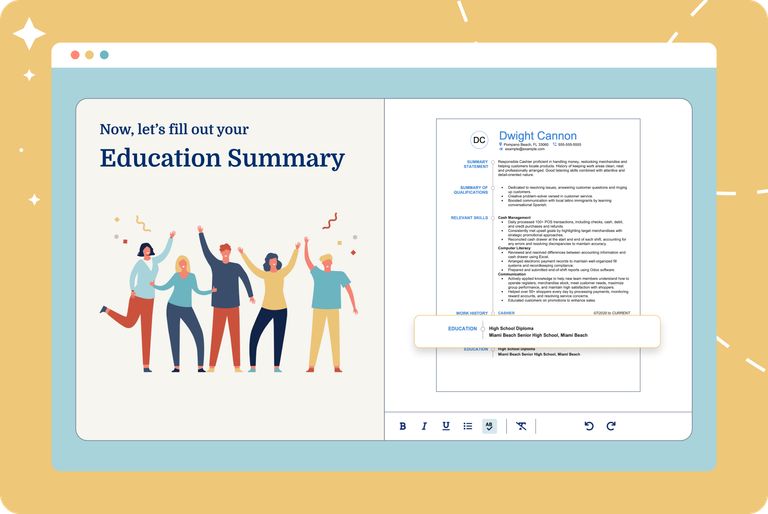Our customers have been hired at: *Foot Note
Confused about the difference between a CV vs a resume? You’re not alone!
While both help you land a job, they’re quite different. In this quick guide, we’ll break down what sets them apart and how to choose the right one for your next job application—whether you’re applying across the street or internationally!
Let’s dive in.
What Is a CV?
A curriculum vitae (CV), meaning “course of life,” is a comprehensive document that displays the full range of a job seeker’s professional life.
Job seekers add to it as a “living document” throughout their careers. A CV template can include information such as research, educational or professional trips, speaking engagements, experiments, publications, memberships, and other sections that display your unique expertise.
What Is a Resume?
A resume is a concise document that highlights a job applicant's most relevant qualifications for a specific role.
A resume template focuses on work experience, skills, and education, making it an ideal tool for quickly showcasing your job qualifications.
Unlike a CV, which provides a comprehensive overview of one's career, a resume should be tailored to each job application, emphasizing only the most pertinent information to catch the employer's attention.
Difference Between a CV and a Resume
In the U.S., resumes vs CVs differ in four key ways:
- Focus: CVs provide a complete recount of a candidate's credentials, while a resume is a snapshot of the applicant's most relevant qualifications.
- Purpose: Job seekers use resumes across most industries, while CVs are reserved for academic, medical, research, or government positions.
- Length: A CV can be several pages long, while a resume is commonly a one-page document.
- Location: CVs are the standard document for job applications anywhere outside the U.S.
Regional differences between a CV and a resume
When applying for jobs internationally, it's important to understand the regional preferences for CVs and resumes because these documents serve different purposes depending on the country.
Understanding these regional differences ensures you present your qualifications appropriately, increasing your chances of making a positive impression on potential employers.
Let’s compare CV vs resume differences worldwide:
United States
- CV: Typically used for academic, medical, legal, and scientific positions. It comprehensively overviews one’s educational background, research, publications, and professional activities.
- Resume: Preferred for most other job applications. It is a concise summary of work experience, relevant skills, and educational background, usually one to two pages long.
United Kingdom
- CV: The term CV is commonly used instead of a resume. It serves as the standard document for all job applications, similar to the resume in the U.S. Still, it may include more detailed sections depending on the job requirements.
- Resume: Less commonly used; the CV is the standard document.
Europe
- CV: In many European countries, the term CV is synonymous with a resume and is used for all job applications. The Europass CV format is often recommended for consistency across EU countries.
- Resume: Rarely used; the CV is the preferred document for job applications.
Asia
- CV: In countries like India, China, and Japan, the term CV is often used interchangeably with resume. However, the content and structure might vary based on local norms and job expectations.
- Resume: The term “resume” may be used, but the format and details required can differ significantly from Western standards.
Australia and New Zealand
- CV: Similar to the U.K., a CV is commonly used for all job applications. It details education, work experience, and skills in a structured format.
- Resume: Less commonly used; the CV is the standard document.
International resume guides
Whether you’re applying for a U.S.-based or international job, our CV-writing guide will ensure your CV is top-notch.
When to Use a CV vs a Resume
Determining when to use a resume vs a CV format can be confusing. Here are some tips to help you decide:
- Check the job description: The easiest way to determine if you need a CV or a resume is to check the job description. Employers often specify the document they prefer.
- Consider your industry: Fields like academia, law, medicine, and research require a a comprehensive overview of your educational background, research, publications, and professional activities. By contrast, industries such as business, marketing, engineering, and technology prefer a targeted summary of your experience and skills.
- Understand geographical differences: In the U.S., resumes are commonly used for most job applications, while CVs are reserved for specific fields. In the U.K. and many other countries in Europe and Asia, CV is the standard document for all job applications.
What to Include in Your CV
CVs are structured similarly to resumes, with five essential sections:
- Contact information
- Summary statement
- Comprehensive job history
- Academic background
- Professional skills
You can use our AI resume skills generator to create a strong resume or CV skills section based on your target role.
AI Resume Skills Generator

However, a key resume vs CV difference is that CVs often include additional sections, such as:
- Research experience
- Teaching or lecturing experience
- Publications
- Conference presentations and speaking engagements
- Language proficiency
- Awards and honors
- Certifications
- Hobbies and interests relevant to your field
- Professional licenses
- Grants, fellowships, and scholarships
- Professional associations and memberships
- Volunteer work
Need ideas for your CV? Our extensive library of professionally designed CV examples can help you create an outstanding CV that showcases your strongest credentials.
What to Include in Your Resume
Keep the following sections in mind when writing your resume:
- Contact information: Your name, phone number, email address, and LinkedIn profile (if applicable) should be prominently displayed at the top of your resume for easy contact.
- Professional summary or objective: Start with a brief statement highlighting your career goals, key skills, and what you bring to the table for potential employers.
- Work experience: Your work history should include a detailed list of your previous jobs, including job titles, companies worked for, dates of employment, and key achievements in each role.
- Education: Summarize your educational background, including degrees earned, institutions attended, and graduation dates. Include relevant coursework, honors, or academic achievements if they enhance your qualifications.
- Skills: Compile a balanced list of hard skills and soft skills that show your suitability for the role.
- Optional sections: Depending on your experience and the job you're applying for, you may include optional sections such as certifications, professional affiliations, volunteer work, languages spoken, or interests relevant to the job.
CV vs Resume Examples
Still wondering what is a CV vs a resume? Check out these professionally designed CV and resume examples to see their differences visually.
Browse over 800+ resume examples for every job across industries.
Professional Tips for Writing a Strong CV or Resume
Crafting a compelling CV or resume requires strategically presenting your skills, achievements, and qualifications to stand out in a competitive job market.
Here are some tips to help you create a strong CV or resume that resonates with recruiters and employers alike:
- Tailor your CV or resume for each job application by incorporating relevant keywords from the job description.
- Present your work experience in reverse-chronological order (most recent job first).
- To boost your job qualifications, begin bullet points with strong action verbs like "managed," "developed,” and "implemented."
- Format your document using standard fonts like Arial and Times New Roman and avoid using images or graphics that can confuse ATS.
- Quantify your achievements with numbers or percentages to demonstrate your impact in previous roles.
- Proofread your document for grammatical errors and typos.
Key Takeaways
Now you know the difference between a CV and a resume! But to ensure you don’t forget, take these key points with you:
- In the U.S., fields like academia, medicine, and law typically use CVs. Resumes are appropriate for any job or industry.
- In most European and some Asian countries, a CV is the standard document used in job applications.
- Typical resume formats can contain up to four optional sections if there is room on one or two pages, but a CV will often contain many sections, depending on the profession and the job’s requirements.
FAQ
Does section order matter for a CV?
The section order for a CV largely depends on your profession and job requirements; however, you must place your contact information and professional profile at the top.
Explore our ChatGPT CV guide for tips on using AI with our CV Maker to craft a job-winning CV in minutes.
How to write a CV with no experience?
Follow these tips for writing the perfect CV with no work experience:
- Write a compelling profile that conveys confidence and enthusiasm.
- Follow your profile with your educational credentials, highlighting any academic awards, grants, fellowships, and honors you have received.
- Create an impressive skills section that shows a range of traits and abilities.
- Wow them with extracurricular and professional activities, publications, thesis, and community service or volunteer activities that show you have the know-how to perform the work.
Read our guide for tips on how to write a resume with no experience.
Which file format should I use for my resume or CV?
The first rule of thumb for file formats is to use the type the potential employer requests in the job ad. If a file format is not specified, use Adobe PDF if you are sending your CV or resume through a job application portal and use a Word .doc file to send your documents through email or mail.
Do you need a cover letter for a CV and a resume?
While not always required, writing a cover letter for your CV or resume allows you to provide information, such as career changes, job gaps, and insight into achievements and professional activities, that a CV or resume can not.
Plus, cover letters allow you to express your personality, connect with the hiring manager, and show off your research skills by giving you space to display your knowledge of the company, organization, or institution so you can match your skills to their needs.
Our customers have been hired at:*Foot Note






